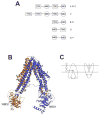ABC multidrug transporters in schistosomes and other parasitic flatworms
- PMID: 23474413
- PMCID: PMC3726539
- DOI: 10.1016/j.parint.2013.02.006
ABC multidrug transporters in schistosomes and other parasitic flatworms
Abstract
Schistosomiasis, a neglected tropical disease affecting hundreds of millions, is caused by parasitic flatworms of the genus Schistosoma. Treatment and control of schistosomiasis relies almost exclusively on a single drug, praziquantel (PZQ), a dangerous situation for a disease of this magnitude. Though PZQ is highly effective overall, it has drawbacks, and reports of worms showing PZQ resistance, either induced in the laboratory or isolated from the field, are disconcerting. Multidrug transporters underlie multidrug resistance (MDR), a phenomenon in which resistance to a single drug is accompanied by unexpected cross-resistance to several structurally unrelated compounds. Some of the best studied multidrug transporters are members of the ancient and very large ATP-binding cassette (ABC) superfamily of efflux transporters. ABC multidrug transporters such as P-glycoprotein (Pgp; ABCB1) are also associated with drug resistance in parasites, including helminths such as schistosomes. In addition to their association with drug resistance, however, ABC transporters also function in a wide variety of physiological processes in metazoans. In this review, we examine recent studies that help define the role of schistosome ABC transporters in regulating drug susceptibility, and in normal schistosome physiology, including reproduction and excretory activity. We postulate that schistosome ABC transporters could be useful targets for compounds that enhance the effectiveness of current therapeutics as well as for agents that act as antischistosomals on their own.
Keywords: ABC transporters; Drug resistance; P-Glycoprotein; Schistosoma.
Copyright © 2013 Elsevier Ireland Ltd. All rights reserved.
Figures

Similar articles
-
Inhibition or knockdown of ABC transporters enhances susceptibility of adult and juvenile schistosomes to Praziquantel.PLoS Negl Trop Dis. 2014 Oct 16;8(10):e3265. doi: 10.1371/journal.pntd.0003265. eCollection 2014 Oct. PLoS Negl Trop Dis. 2014. PMID: 25330312 Free PMC article.
-
Pharmacology and potential physiological significance of schistosome multidrug resistance transporters.Exp Parasitol. 2012 Sep;132(1):2-6. doi: 10.1016/j.exppara.2011.03.004. Epub 2011 Mar 21. Exp Parasitol. 2012. PMID: 21420955 Free PMC article. Review.
-
Schistosome ABC multidrug transporters: From pharmacology to physiology.Int J Parasitol Drugs Drug Resist. 2014 Sep 26;4(3):301-9. doi: 10.1016/j.ijpddr.2014.09.007. eCollection 2014 Dec. Int J Parasitol Drugs Drug Resist. 2014. PMID: 25516841 Free PMC article. Review.
-
New approaches for understanding mechanisms of drug resistance in schistosomes.Parasitology. 2013 Oct;140(12):1534-46. doi: 10.1017/S0031182013000231. Epub 2013 Apr 3. Parasitology. 2013. PMID: 23552512 Free PMC article. Review.
-
Schistosoma mansoni express higher levels of multidrug resistance-associated protein 1 (SmMRP1) in juvenile worms and in response to praziquantel.Mol Biochem Parasitol. 2010 Sep;173(1):25-31. doi: 10.1016/j.molbiopara.2010.05.003. Epub 2010 May 12. Mol Biochem Parasitol. 2010. PMID: 20470831 Free PMC article.
Cited by
-
Form and Function in the Digenea, with an Emphasis on Host-Parasite and Parasite-Bacteria Interactions.Adv Exp Med Biol. 2024;1454:3-45. doi: 10.1007/978-3-031-60121-7_1. Adv Exp Med Biol. 2024. PMID: 39008262 Review.
-
Transcriptomic analysis of reduced sensitivity to praziquantel in Schistosoma mansoni.Mol Biochem Parasitol. 2019 Mar;228:6-15. doi: 10.1016/j.molbiopara.2018.12.005. Epub 2019 Jan 15. Mol Biochem Parasitol. 2019. PMID: 30658180 Free PMC article.
-
WIPO Re:Search-A Platform for Product-Centered Cross-Sector Partnerships for the Elimination of Schistosomiasis.Trop Med Infect Dis. 2019 Jan 9;4(1):11. doi: 10.3390/tropicalmed4010011. Trop Med Infect Dis. 2019. PMID: 30634429 Free PMC article.
-
Whole-genome sequencing of Schistosoma mansoni reveals extensive diversity with limited selection despite mass drug administration.Nat Commun. 2021 Aug 6;12(1):4776. doi: 10.1038/s41467-021-24958-0. Nat Commun. 2021. PMID: 34362894 Free PMC article.
-
Effect of praziquantel on the differential expression of mouse hepatic genes and parasite ATP binding cassette transporter gene family members during Schistosoma mansoni infection.PLoS Negl Trop Dis. 2017 Jun 26;11(6):e0005691. doi: 10.1371/journal.pntd.0005691. eCollection 2017 Jun. PLoS Negl Trop Dis. 2017. PMID: 28650976 Free PMC article.
References
-
- van der Werf MJ, de Vlas SJ, Brooker S, Looman CW, Nagelkerke NJ, Habbema JD, Engels D. Quantification of clinical morbidity associated with schistosome infection in sub-Saharan Africa. Acta Tropica. 2003;86:125–39. - PubMed
-
- King CH, Dangerfield-Cha M. The unacknowledged impact of chronic schistosomiasis. Chronic Illness. 2008;4:65–79. - PubMed
-
- Caffrey CR. Chemotherapy of schistosomiasis: present and future. Current Opinion in Chemical Biology. 2007;11:433–9. - PubMed
Publication types
MeSH terms
Substances
Grants and funding
LinkOut - more resources
Full Text Sources
Other Literature Sources
Miscellaneous

